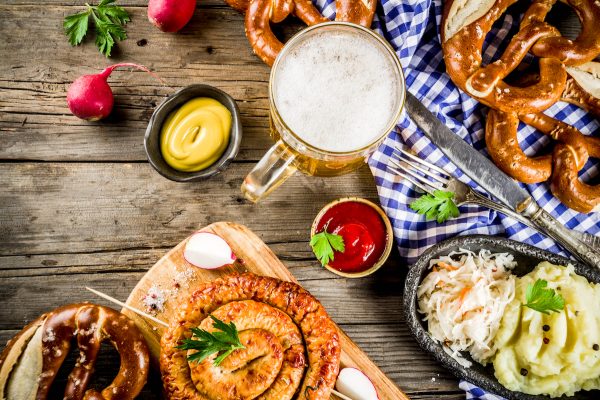In the United States, there are some foods that we know and love as “American food.” Hotdogs line the grill and light beers are drank every Fourth of July, cinnamon rolls appear on breakfast tables, and casseroles are served for dinner when parents are busy (and all the kids have sports practice). These dishes are staples of our childhoods and are therefore associated with the culture in which we were raised. Yet, none of these foods are traditionally American, but instead moved here alongside German immigrants—changed over time from home cook to home cook. So, how have these foods strayed from their traditional German roots, and which foods that we know as American are originally German?
American Studies professor and historian Tanfer Emin Tunc investigates the importance of food and its resulting scarcity during the First World War, emphasizing how this absence of food was used to drive anti-German propaganda in the United States. The main argument Tunc conveys in her article solidifies the start of the use of food as war propaganda in the United States, beginning in WWI and with the renaming of German foods, annihilating any form of possible pro-German sentiment and converting this food into identifiably “American” dishes. Tunc’s inclusion of various WWI-era propaganda posters and the context for their creation from specific Committee on Public Information (CPI) objectives (created under Presidents Wilson and Hoover) accounts for the reasoning behind the creation of specific food propaganda during this era and its significance in American culture. This work is useful for my study of the Americanization of German food because it allows me to specifically identify a point in American history (WWI) where German food and culture were scrutinized, and the resulting effects of this scrutiny on German and American food culture.
The chapter “German American Food” in The Oxford Encyclopedia of Food and Drink in America, edited by Andrew F. Smith, delves into almost every facet of German American cuisine, from traditional German dishes to dishes that have been construed over time, becoming the “American” foods we know today. The chapter utilizes both census data and geographical data to convey the percentage of German Americans within the U.S. population and the effects that this group has on the food culture of the country. This source is useful for my study of the Americanization of German food because it provides specific evidence of the conversion of German and Pennsylvania Dutch dishes to more identifiably American ones, explaining the timeline of this conversion and the factors that caused this food to change.
German food has a long and complicated history, like the foods of most other cultures. With the emigration of German citizens to the United States, the concept of German national identity was instantly changed, as one was only considered “German” if they spoke the language, not if they hailed from the country itself. Therefore, the history of German Americans and their cuisine is a complicated (and even blurred) one. Identity confusion fueled the modification of many traditional German dishes, as immigrants felt the need to assimilate into American culture in every way possible—even by changing their food. The digestion of German dishes into American food culture has created traditional “American” dishes we know today like the hotdog and the casserole. Yet, in recognizing the traditional German roots of classic American dishes like these, one can better understand the rich history of American food—and the German cooks and their recipes that influenced it.
The United States of America is known as the “melting pot;” a heated mixture of different languages, cultures, and identities stewed and mixed until a final, delicious dish is made. One can best appreciate this melting pot by breaking it down and understanding its ingredients—the cultures and the people themselves that make its flavors and aromas. Food is at the center of culture itself: it is how we as people are able to connect with one another and understand each other’s lives and stories. German Americans have largely contributed to the food culture of the United States, with their traditional recipes adapting over time to fit American norms and standards. In researching the history of German immigrants and their cuisine, Americans can have a better appreciation for the foods that frequent their memories and their tables: the donuts we can’t get enough of and casseroles we know and love.
Sources:
“Andy Warhol, Campbell’s Soup Cans, 1962.” Museum of Modern Art (MoMA), 2025, https://www.moma.org/collection/works/79809. Accessed 6 November 2025.
Butler, Stephanie. “The Hardships of Civil War Eating.” History.com, A&E Television Networks, 5 July 2013, https://www.history.com/articles/desecrated-vegetables-the-hardships-of-civil-war-eating. Accessed 6 November 2025.
“Campbell’s History.” The Campbell’s Company, https://www.thecampbellscompany.com/about-us/our-story/campbell-history/. Accessed 6 November 2025.
Davidis, Henriette. Pickled Herring and Pumpkin Pie: A Nineteenth-Century Cookbook for German Immigrants to America. Madison Wisconsin: Max Kade Institute for German-American Studies, University of Wisconsin-Madison, 2002.
“During World War I, U.S. Government Propaganda Erased German Culture.” All Things Considered from NPR, 7 April 2017, https://www.npr.org/2017/04/07/523044253/during-world-war-i-u-s-government-propaganda-erased-german-culture.
“German American Food.” The Oxford Encyclopedia of Food and Drink in America, edited by Andrew F. Smith. Oxford University Press, 2013. Oxford Reference. www.oxfordreference.com/display/10.1093/acref/9780199734962.001.0001/acref-9780199734962-e-0354?rskey=7GIzwx&result=493.
Glaser, et al. “Climate of migration? How climate triggered migration from southwest Germany to North America during the 19th century.” Climate of the Past, vol. 13, 2017, pp. 1573-1592, research.ebsco.com/c/6uxpnv/viewer/pdf/awzv3nucrv. Accessed 6 November 2025.
Grabbe, Hans-Jürgen. “The Phasing-Out of 18th-Century Patterns of German Migration to the United States after 1817.” American Studies Journal, vol. 62, 2017, www.asjournal.org/62-2017/phasing-18th-century-patterns-german-migration-united-states-1817/. Accessed 6 November 2025.
“Growth of Nationalism in Germany, 1815-1850.” BBC Bitesize, https://www.bbc.co.uk/bitesize/guides/zqyrcdm/revision/2. Accessed from 6 November 2025.
Leahy, Kate. “Restaurants are Winning with German Cuisine.” US Foods, https://www.usfoods.com/great-food/food-trends/restaurants-go-deutsch-with-german-cuisine.html. Food Fanatics Magazine, Accessed 6 November 2025.
Tunc, Tanfer Emin. “Less Sugar, More Warships: Food as American Propaganda in the First World War.” War in History, vol. 19, no. 2, 2012, pp. 193-216. OhioLINK Electronic Journal Center, rave.ohiolink.edu/ejournals/article/331073265. Accessed 6 November 2025.
